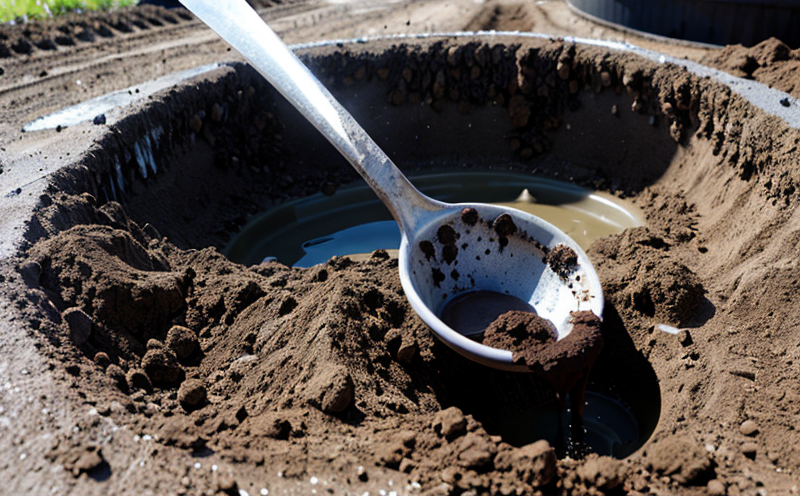EPA 7471 Mercury in Biosolids by CVAA Test
The Mercury in Biosolids by CVAA (Continuous Volatile Acid Digestion) test, as per EPA Method 7471, is a robust and reliable analytical procedure for quantifying mercury content in biosolids. This method is crucial for ensuring compliance with regulatory standards set forth by the U.S. Environmental Protection Agency (EPA) to protect public health and the environment from potential risks associated with mercury contamination.
Biosolids are an essential component of wastewater treatment processes, providing a valuable resource for soil amendment and agricultural applications. However, the presence of trace levels of toxic metals like mercury can pose significant challenges if not properly managed. EPA Method 7471 provides a standardized approach to accurately quantify mercury in biosolids, ensuring that these materials are suitable for beneficial use.
The CVAA digestion process involves subjecting the biosolid sample to continuous volatile acid digestion at elevated temperatures and pressures. This step is designed to break down organic matter and liberate trace elements including mercury into a solution where it can be accurately measured using atomic absorption spectrophotometry (AAS). The precision and accuracy of this method make it an indispensable tool for laboratories tasked with ensuring the safety of biosolid products.
The EPA 7471 CVAA test is widely used in quality management, compliance, and R&D activities within the wastewater treatment sector. Compliance officers rely on this method to ensure that biosolids meet regulatory limits set by the EPA, while R&D engineers use it to optimize processes and improve product safety. For procurement teams, accurate mercury content data from CVAA tests helps select suppliers who adhere to stringent quality standards.
The methodology is based on several key steps:
- Sample Preparation: Biosolid samples are thoroughly homogenized and weighed according to EPA guidelines.
- Digestion: Samples undergo CVAA digestion, a process that involves heating the sample with hydrochloric acid (HCl) under controlled conditions to release mercury from its bound form.
- Analytical Determination: The digested solution is analyzed using atomic absorption spectrophotometry (AAS). This instrument measures the amount of mercury present in the biosolid matrix by detecting the characteristic spectrum emitted when a sample is vaporized and excited at specific wavelengths.
The results from EPA Method 7471 are reported as concentrations of total mercury, expressed in units such as micrograms per kilogram (µg/kg) or parts per million (ppm). These values provide critical insights into the safety profile of biosolid products and guide decisions regarding their beneficial use.
The CVAA method is recognized for its high accuracy and precision. It minimizes matrix effects, ensuring that only mercury ions are measured accurately. This makes it particularly suitable for detecting low levels of mercury in complex environmental samples like biosolids.
Compliance with EPA Method 7471 ensures that wastewater treatment facilities meet stringent regulatory requirements set forth by the U.S. government. By adhering to this standard, laboratories and testing centers can provide reliable data supporting safer handling and utilization of biosolid products.
Benefits
The EPA 7471 Mercury in Biosolids by CVAA Test offers numerous benefits to various stakeholders involved in wastewater treatment, biosolid production, and environmental management:
- Regulatory Compliance: Ensures that biosolid products meet the stringent requirements set forth by the U.S. Environmental Protection Agency.
- Safety Assurance: Provides accurate mercury content data to safeguard public health and protect the environment from potential risks associated with mercury contamination.
- Better Decision-Making: Enables informed choices regarding the beneficial use of biosolids in agriculture, land reclamation, and other applications.
- Enhanced Reputation: Demonstrates a commitment to environmental stewardship and responsible resource management, enhancing the reputation of wastewater treatment facilities and their suppliers.
- Improved Efficiency: Streamlines compliance processes and reduces the likelihood of non-compliance fines or penalties.
The accurate and reliable data generated by this test supports evidence-based decision-making at every stage of biosolid production, from laboratory analysis to field application. This ensures that biosolids are used safely and effectively while minimizing environmental impact.
Environmental and Sustainability Contributions
The EPA 7471 Mercury in Biosolids by CVAA Test plays a pivotal role in promoting environmental sustainability and public health. By accurately quantifying mercury content in biosolids, this method helps mitigate the risk of mercury contamination when these materials are used for beneficial purposes such as soil amendment or land reclamation.
- Reduced Environmental Impact: Ensures that only low-mercury biosolid products are released into the environment, minimizing potential harm to ecosystems and wildlife.
- Sustainable Resource Use: Promotes responsible management of wastewater treatment residuals by ensuring that biosolids are used safely and effectively in agricultural and land reclamation projects.
- Public Health Protection: By accurately quantifying mercury content, this method helps prevent the release of harmful levels of mercury into the environment, thereby protecting public health.
The accurate and reliable data generated by EPA Method 7471 supports informed decision-making in biosolid production and utilization, ensuring that these materials are used safely and effectively. This not only enhances environmental sustainability but also promotes responsible resource management practices.
Competitive Advantage and Market Impact
The ability to accurately quantify mercury content in biosolids using EPA Method 7471 provides wastewater treatment facilities, testing laboratories, and suppliers with a significant competitive advantage. This method ensures that products meet or exceed regulatory requirements, thereby enhancing the reputation of these entities in the marketplace.
- Enhanced Reputation: By demonstrating compliance with stringent environmental standards, organizations can build trust and credibility among customers, stakeholders, and regulators.
- Informed Decision-Making: Accurate data on mercury content allows for informed decisions regarding the safe use of biosolid products, leading to better resource management practices.
- Market Differentiation: Organizations that can demonstrate their commitment to environmental stewardship through accurate and reliable testing are more likely to attract environmentally conscious customers and partners.
The high demand for sustainable and responsibly managed resources in the agricultural and land reclamation sectors means that entities capable of providing accurate mercury content data stand out from competitors. This not only enhances market positioning but also drives innovation and continuous improvement in biosolid production processes.





